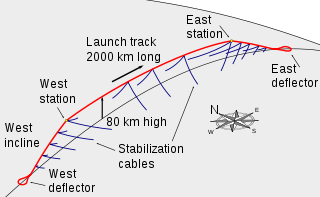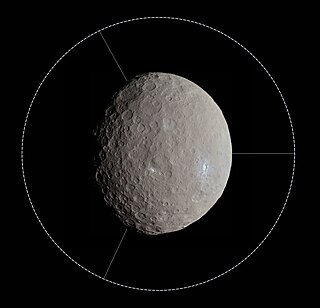Related Research Articles

A space elevator, also referred to as a space bridge, star ladder, and orbital lift, is a proposed type of planet-to-space transportation system, often depicted in science fiction. The main component would be a cable anchored to the surface and extending into space. An Earth-based space elevator cannot be constructed with a tall tower supported from below due to the immense weight—instead, it would consist of a cable with one end attached to the surface near the equator and the other end attached to a counterweight in space beyond geostationary orbit. The competing forces of gravity, which is stronger at the lower end, and the upward centrifugal force, which is stronger at the upper end, would result in the cable being held up, under tension, and stationary over a single position on Earth. With the tether deployed, climbers (crawlers) could repeatedly climb up and down the tether by mechanical means, releasing their cargo to and from orbit. The design would permit vehicles to travel directly between a planetary surface, such as the Earth's, and orbit, without the use of large rockets.

A geostationary orbit, also referred to as a geosynchronous equatorial orbit (GEO), is a circular geosynchronous orbit 35,786 km (22,236 mi) in altitude above Earth's equator, 42,164 km (26,199 mi) in radius from Earth's center, and following the direction of Earth's rotation.

A skyhook is a proposed momentum exchange tether that aims to reduce the cost of placing payloads into low Earth orbit. A heavy orbiting station is connected to a cable which extends down towards the upper atmosphere. Payloads, which are much lighter than the station, are hooked to the end of the cable as it passes, and are then flung into orbit by rotation of the cable around the center of mass. The station can then be reboosted to its original altitude by electromagnetic propulsion, rocket propulsion, or by deorbiting another object with the same kinetic energy as transferred to the payload.
Space elevator economics compares the cost of sending a payload into Earth orbit via a space elevator with the cost of doing so with alternatives, like rockets.

A lunar space elevator or lunar spacelift is a proposed transportation system for moving a mechanical climbing vehicle up and down a ribbon-shaped tethered cable that is set between the surface of the Moon "at the bottom" and a docking port suspended tens of thousands of kilometers above in space at the top.

A megastructure is a very large artificial object, although the limits of precisely how large vary considerably. Some apply the term to any especially large or tall building. Some sources define a megastructure as an enormous self-supporting artificial construct. The products of megascale engineering or astroengineering are megastructures. The lower bound of megastructural engineering might be considered any structure that has any single dimension 1 megameter (1000 km) in length.
Megascale engineering is a form of exploratory engineering concerned with the construction of structures on an enormous scale. Typically these structures are at least 1,000 km (620 mi) in length—in other words, at least one megameter, hence the name. Such large-scale structures are termed megastructures.
A momentum exchange tether is a kind of space tether that could theoretically be used as a launch system, or to change spacecraft orbits. Momentum exchange tethers create a controlled force on the end-masses of the system due to the pseudo-force known as centrifugal force. While the tether system rotates, the objects on either end of the tether will experience continuous acceleration; the magnitude of the acceleration depends on the length of the tether and the rotation rate. Momentum exchange occurs when an end body is released during the rotation. The transfer of momentum to the released object will cause the rotating tether to lose energy, and thus lose velocity and altitude. However, using electrodynamic tether thrusting, or ion propulsion the system can then re-boost itself with little or no expenditure of consumable reaction mass.

A launch loop, or Lofstrom loop, is a proposed system for launching objects into orbit using a moving cable-like system situated inside a sheath attached to the Earth at two ends and suspended above the atmosphere in the middle. The design concept was published by Keith Lofstrom and describes an active structure maglev cable transport system that would be around 2,000 km (1,240 mi) long and maintained at an altitude of up to 80 km (50 mi). A launch loop would be held up at this altitude by the momentum of a belt that circulates around the structure. This circulation, in effect, transfers the weight of the structure onto a pair of magnetic bearings, one at each end, which support it.

An orbital ring is a concept of an artificial ring placed around a body and set rotating at such a rate that the apparent centrifugal force is large enough to counteract the force of gravity. For the Earth, the required speed is on the order of 10 km/sec, compared to a typical low Earth orbit velocity of 8 km/sec. The structure is intended to be used as a space station or as a planetary vehicle for very high-speed transportation or space launch.
This is a list of occurrences of space elevators in fiction. Some depictions were made before the space elevator concept became fully established.
The specific strength is a material's strength divided by its density. It is also known as the strength-to-weight ratio or strength/weight ratio or strength-to-mass ratio. In fiber or textile applications, tenacity is the usual measure of specific strength. The SI unit for specific strength is Pa⋅m3/kg, or N⋅m/kg, which is dimensionally equivalent to m2/s2, though the latter form is rarely used. Specific strength has the same units as specific energy, and is related to the maximum specific energy of rotation that an object can have without flying apart due to centrifugal force.

Space-based solar power is the concept of collecting solar power in outer space with solar power satellites (SPS) and distributing it to Earth. Its advantages include a higher collection of energy due to the lack of reflection and absorption by the atmosphere, the possibility of very little night, and a better ability to orient to face the sun. Space-based solar power systems convert sunlight to some other form of energy which can be transmitted through the atmosphere to receivers on the Earth's surface.

Elevator:2010 was an inducement prize contest with the purpose of developing space elevator and space elevator-related technologies. Elevator:2010 organized annual competitions for climbers, ribbons and power-beaming systems, and was operated by a partnership between Spaceward Foundation and the NASA Centennial Challenges.

Non-rocket spacelaunch refers to theoretical concepts for launch into space where much of the speed and altitude needed to achieve orbit is provided by a propulsion technique that is not subject to the limits of the rocket equation. Although all space launches to date have been rockets, a number of alternatives to rockets have been proposed. In some systems, such as a combination launch system, skyhook, rocket sled launch, rockoon, or air launch, a portion of the total delta-v may be provided, either directly or indirectly, by using rocket propulsion.
There are risks associated with never-done-before technologies like the construction and operation of a space elevator. A space elevator would present a navigational hazard, both to aircraft and spacecraft. Aircraft could be dealt with by means of simple air-traffic control restrictions. Impacts by space objects such as meteoroids, satellites and micrometeorites pose a more difficult problem for construction and operation of a space elevator.

A number of space tethers have been deployed in space missions. Tether satellites can be used for various purposes including research into tether propulsion, tidal stabilisation and orbital plasma dynamics.

Space tethers are long cables which can be used for propulsion, momentum exchange, stabilization and attitude control, or maintaining the relative positions of the components of a large dispersed satellite/spacecraft sensor system. Depending on the mission objectives and altitude, spaceflight using this form of spacecraft propulsion is theorized to be significantly less expensive than spaceflight using rocket engines.
A space elevator is a theoretical system using a super-strong ribbon going from the surface of the Earth to a point beyond Geosynchronous orbit. The center of gravity of the ribbon would be exactly in geosynchronous orbit, so that the ribbon would always stay above the anchor point. Vehicles would climb the ribbon powered by a beam of energy projected from the surface of the Earth. Building a space elevator requires materials and techniques that do not currently exist. A variety of Space Elevator competitions have been held in order to stimulate the development of such materials and techniques.
Hypothetical technology is technology that does not exist yet, but that could exist in the future. This article presents examples of technologies that have been hypothesized or proposed, but that have not been developed yet. An example of hypothetical technology is teleportation.
References
- ↑ D.V. Smitherman (Ed.), Space Elevators: An Advanced Earth-Space Infrastructure for the New Millennium Archived 2015-03-28 at the Wayback Machine , NASA/CP-2000-210429, Marshall Space Flight Center, Huntsville, Alabama, 2000
- 1 2 3 Hein, A.M., Producing a Space Elevator Tether Using a NEO: A Preliminary Assessment, International Astronautical Congress 2012, IAC-2012, Naples, Italy, 2012
- 1 2 Pearson, J. (1975). The orbital tower: a spacecraft launcher using the Earth's rotational energy. Acta Astronautica, 2(9), 785-799.
- ↑ "The Space Elevator: Phase I Study" by Bradley Carl Edwards
- ↑ Gassend, Blaise. "Exponential Tethers for Accelerated Space Elevator Deployment" (PDF). Retrieved 2006-03-05.
- ↑ The specific strength of 100 meganewtons/(kg/m) is for a constant cross section cable and a safety factor of 2. The ability to build with a constant cross section cable has some advantages, but is not necessary. Tapering the cable cross section from a maximum at the geosynchronous orbit level to minimums at the bottom and top allows construction with materials having less specific strength. The minimum specific strength required for a tapered cable depends largely on launch budget and other financial factors. A 30 meganewton/(kg/m) lower limit has been mentioned as a goal for specific strength to be able to support a reasonably financially feasible space elevator -- the motto of the 2011 Space Elevator Conference was "30 MegaYuris or Bust!". A "Yuri" here is used as the unit representing one Newton/(kg/m).
- ↑ "How close is the Space Elevator? How expensive will it be?- Data Point References". Archived from the original on 2013-06-01. Retrieved 2014-04-19.
- ↑ "Results from Japan's 2010 JSETEC Competition". 2010-08-11. Retrieved 2011-04-23.
- 1 2 3 4 Nugent, Tom (2009-11-07). "Highlights from 2009 Competition". LaserMotive. Archived from the original on 2012-03-16. Retrieved 2011-04-23.
- ↑ Space elevator#Cable
- ↑ Space elevator#Climbers
